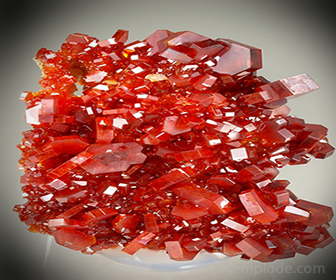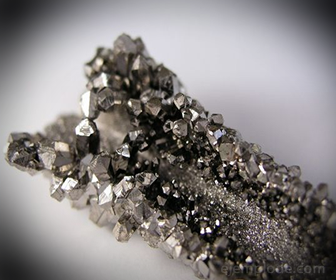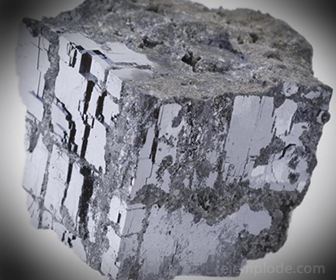Vanadium Niobium And Tantalum
Chemistry / / July 04, 2021
The elements of the group Vanadium, Niobium and Tantalum are for their physical characteristics similar to steel. Have high melting and boiling points, and are alloyed with Iron to produce special steels. They are quite resistant to chemical action, and only combine with oxygen if they are heated to high temperatures.
Although these elements have a frankly metallic character, are usually found as salts of their oxyacids, that is, as Vanadates (VO4-3), Niobiates (NbO3-1) and Tantalates (TaO3-1).
Vanadium
The Vanadium it's a Chemical element of Atomic Number 23 and symbol V. It is among the Transition Metals in the second group, accompanied by Niobium and Tantalum.
His Atomic mass is 50.942 g / mol. Has a density from 6110 Kg / m3. His Melting point It is at a temperature of 1902 ° C. His Boiling point it is at 3409 ° C.
It is capable of conducting electric current, with a Electric conductivity from 4.89x106 S / m (Siemens every meter). His Thermal conductivity equals 30.7 W / (K * m) (Watts per Kelvin-meter).
Due to the varied and intense colors of its compounds, N. G. Sefström, who discovered it in 1830, gave this metal the name Vanadium in honor of the Scandinavian goddess Vanadis. The element is found in Vanadinite [Pb3(VO4)2* PbCl2], in Carnotita [K2O * 2UO3* V2OR5* 3H2O] and in the Patronita VS3.
Also It is found in the coal of Peru, whose ashes contain up to 48% Vanadium Pentoxide (V2OR5).
The metal is obtained by reducing the oxide with carbon or hydrogen, allocating large quantities of it to the manufacture of special steels. Adding 0.5% to 1% Vanadium increases the tensile strength of a steel sample from 1.16 to 2 tons per square centimeter.
Vanadium forms various oxides, acidic in nature. The salts of the different oxides are colored: those of V2OR2 for example, they are blue of lavender (lavender); those of V2OR3 green; those of V2OR4 blue, and those of V2OR5 orange.
Vanadium Pentoxide V2OR5 and some of the salts derived from it are used as catalysts in the contact method to obtain Sulfuric Acid.

Niobium
The Niobium it's a Chemical element of Atomic Number 41 and symbol Nb. It is among the Transition Metals in the second group, accompanied by Vanadium and Tantalum.
Originally called Columbioand with symbol Cb, was discovered in 1801 by C. Hatchett in the mineral Columbite Fe (CbO3)2. There are no known important applications of this element or its compounds.
His Atomic mass is 92.906 g / mol. Has a Density of 8570 Kg / m3. His Melting point is located at 2477 ° C, and its Boiling point It is at an extremely high temperature of 4744 ° C.
Has a Electric conductivity from 6.93x106 S / m (Siemens every meter). His Thermal conductivity is 53.7 W / (K * m) (Watts per Kelvin-meter).

Tantalum
The Tantalum it's a Chemical element of Atomic Number 73 and symbol Ta. It is among the Transition Metals in the second group, accompanied by Vanadium and Niobium.
In 1802, A. G. Ekeberg found a new element in a mineral with the formula Fe (TaO3)2, similar to Columbite, and gave it the name of Tantalus, alluding to the difficulties that the dissolution of the mineral offered.
His Atomic mass is 180.95 g / mol. Has a Density from 16650 Kg / m3, almost double that of Niobium. His Melting point is located at a temperature of 3017 ° C, and its Boiling point it is reached at 5458 ° C. These are temperatures that are only reached in highly controlled industrial circumstances.
His Electric conductivity has a value of 7.61x106 S / m (Siemens every meter). His Thermal conductivity equals 57.5 W / (K * m) (Watts per Kelvin-meter).
Due to its ductility, great resistance to electric current and very high Melting Point, it was used as a filament in incandescent lamps; but it has been completely replaced by Tungsten, also called Tungsten, very abundant and easy to obtain in its pure state.
The Tantalum can be hardened by alloy with small amounts of other elements. Such alloys are used to make stainless tools and instruments, which can be sterilized in a flame without damaging the cut. Tantalum Carbide is extremely hard, and is used as a cutting tool in steel working machines.

Examples of Vanadium, Niobium and Tantalum Compounds
Vanadium dioxide (V2OR2)
Vanadium trioxide (V2OR3)
Vanadium Tetroxide (V2OR4)
Vanadium pentoxide (V2OR5)
Vanadinite [Pb3(VO4)2* PbCl2]
Carnotite [K2O * 2UO3* V2OR5* 3H2OR]
Patronite (VS3)
Columbite Fe (NbO3)2
Niobium Monophosphide (NbP)
Niobium Oxide (NbO)
Niobium Boride (NbB)
Niobium Carbide (NbC)
Iron Tantalate [Fe (TaO3)2]
Tantalum Carbide (Ta2C)

